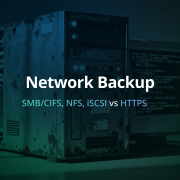
Full copy, incremental copy, and differential copy – backup types
Full copy, incremental copy, differential copy… today we are going to talk about different backup types. We will start from absolute basics, but more experienced in that field reader should be able to find something interesting as well.
If the premise of backup would only be to copy the files from location A to location B, there would be no need for complex backup solutions (either on-premise or cloud backup). To complete that task, the program would only need to include one script. So what does a dedicated backup solution offer?
What can we find apart from a “clickable” interface, one console being able to control many devices or some additional features like compression or encryption? The most important advantage of backup solutions is that you can define what type of copy you want to create. Will the system create a full copy every time, or maybe it can use methods greatly decreasing needed space to store the copies? Let’s see what compromises we need to make, to save storage space.
Full, Incremental, and Differential copies – one backup many possibilities
Creating a backup, the administrator has an option to choose what type of copy he wants to perform. It can be:
- Full copy
- Incremental copy
- Differential copy
All those types of copies are a good way to make sure your data is secure, and it’s obvious that there are differences between them. They can be simplified to whether you want to ensure quick disaster recovery times, or you want to optimize the storage space you have.
Full copy (Mirror)
To ensure that our files, disc images, databases, and other important information is secure, we create a copy of them in the safe location. That copy can be encrypted or compressed with a variety of algorithms, but for sure it should contain full information about the file. That’s why it’s called a Full Copy.
For example, let’s assume that we create a full copy every day, 7 days a week. In that case every day in the storage will be created a full copy of data.
When it comes to recovery from that type of backup, it’s really simple – all you need to do is recover the chosen version, and the user has access to that data.
The big disadvantage of that type of copies is that it will consume a lot of available storage.
Pros:
- Fast recovery time
Cons:
- Require a lot of storage space
- Long time of backup execution
Incremental copy
Incremental backup’s premise is to create one full copy of the data, and then a chain of incremental copies. What are incremental copies? In that type of copies we only save the information that changed in the file, since the time the last copy was performed. Especially when it comes to big files, where not much changes over time, we would see increased speed of performing the backup. But time is not the only time we save, we also save a lot of storage space – incremental copies take less storage space.
The disadvantage of that type of copy is for sure slower recovery time. To recover the last incremental copy made, the system needs to recover the full copy made, and all incremental copies made before. The more incremental copies were made, the longer it takes for the system to recover the file – it need to fit together more data.
To effectively use the incremental copies, you can create a full copy from time to time so that the number of incremental copies isn’t too long. That way is named – mixed incremental backup.
Pros:
- Quick creation of copy
- More effective way to use storage
Cons:
- Slow data recovery
- Increased network use
- Requires more space to save all versions
Differential copies
Differential backup is a backup model placed somewhere between two previous types. The first copy created is a full copy. The second one will be the same as in Incremental backup – we will copy only the data that changed from the full backup. But when it comes to the next copies created, we will copy the changes but always in relation to the last full copy, not the previous one.
To recover the data, all you need to do is to combine two sets of data the one from full copy, and the differential one we want to recover.
The disadvantage is the rising amount of storage space needed for the next differential copy. A very possible situation is that the differential copy will be completely different from the original copy, and thus taking the same, or even more storage space.
It’s common to also create a mixed differential backup, to neglect the negative impact of every growing differential copy.
Pros:
- Less storage space required than for full copy
- Fast recovery time – you only require 2 data sets
Cons:
- The further from the last full copy, the bigger the copies
Full copy, incremental copy, differential copy – what to choose?
If you have a very limited storage space – ideal would be incremental copies. But when you want to balance your backup – you should try differential backup.






